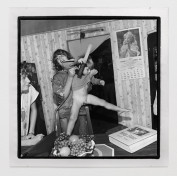JTF (just the facts): A total of 14 large scale black and white photographs, pinned/unframed, and displayed against white walls in the single room gallery space and the entry area. All of the works are gelatin silver prints, made between 1990 and 1992 and printed in 1993. Each is sized 35×35. This is the first solo show of these images in the United States. A monograph of this body of work was published by Cornerhouse Publications in 1994.
Comments/Context: Coming on the heels of the recent presidential elections here in the United States, this show of Susan Lipper’s photographs from rural West Virginia are particularly timely. For many living in the big cities on the coasts, the election of Donald Trump came as an unthinkable surprise, raising thorny questions about just how far out of touch many are with the realities of life in the middle of the country. And so we turn to photographs to help us understand and recalibrate.
The problem is that most of images from the mountainous regions of Appalachia and its depressed areas of vanishing coal production are filled with visual clichés and stereotypes. We know what the pictures will look like even before we see them – punishing poverty, mixed with unemployment, guns, violence, drugs, boredom, and broken families with dirty faces and feral children – and so they almost fail to register. Instead, they confirm ingrown expectations rather than pushing us to think differently.
And at first glance, Lipper’s square format images (taken in the early 1990s) seem to fall right into this familiar pattern. Ornery white people brandish guns, string up dead deer, burn tires for fun, and dress up in shiny KKK hoods for kicks. With nothing much to do, they drink beers in the backyard pool, blow pot smoke in each other’s faces, goof around in rubber masks, and retell stories about gunshot scars. Between the Pentecostal snakes, the snarling taxidermy raccoons, and the dark shadows that inhabit the pictures, there is a consistently brooding sense of animalistic danger, with menace lurking just out of sight.
And yet, if this was all that Lipper’s photographs could show us, we might simply chalk them up as well made examples of the now typical American rural decay aesthetic. But the twist in this story (spoiler alert) is that these pictures are not straight documents. Lipper spent an intermittent period of five years in Grapevine Branch, West Virginia, and her images were made in collaboration with the residents there. Her subjects are in effect performing, and were given the ability to see the images and refine their poses and expressions in subsequent shoots. So all of the clichés that are present in the images were deliberately put there by her sitters.
When we let that bombshell sink in a bit, it gives Lipper’s photographs plenty of additional layers of nuanced meaning. The flipping of the coin from exploitation to intention is radical – it forces us to see these “characters” and “scenes” as desired outcomes rather than stolen moments. So the grimace of the man holding the handgun is a choice, as are the pants-less child swung through the living room and the dazed vacant stares of the men getting wasted in the pool. This what they wanted us to see (with Lipper’s help and direction of course), and they presumably approved the final pictures. So what we have is a constructed reality that mimics the stereotypical one, where each image is a meta-document of a performance of the residents’ version of everyday truth. Conceptually, that is a rich meal for us to digest.
To my eye, this gives Lipper’s images a kind of rough-and-tumble defiance, that is delivered with quietly swaggering self-awareness. While outsiders might still see the ugliness, narrowness, and outright despair in these lives, the subjects themselves seem to understand and accept the shape of their reality, even to the point of playing with the edges of its darkest humor. What they seem to want is simple acknowledgement of these sometimes bleak perspectives and choices, and that I think is where Donald Trump returns to the conversation. These are folks who undeniably know they are in a depressing trap with few good solutions, and just want someone to pay attention.
Collector’s POV: The prints in this show are priced at $9000 each. Lipper’s work has little secondary market history, so gallery retail likely remains the best option for those collectors interested in following up.

